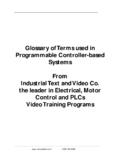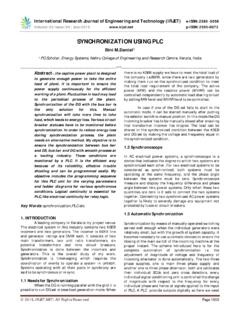Transcription of National Grid UK Electricity Transmission plc
1 National Grid UK Electricity Transmission plc NGUK/PM/ETSR/NSI/02/GN Issue 9 National Safety Instruction and Guidance National Grid plc 2016 All Rights Reserved Uncontrolled when printed National Grid UK Electricity Transmission plc Uncontrolled when printed National SAFETY INSTRUCTION and Guidance NSI 2 EARTHING HIGH VOLTAGE EQUIPMENT Copyright National Grid plc 2016 , all rights reserved. No part of this publication may be reproduced, stored in a retrieval system, or transmitted in any form or by any means electronic, mechanical, photocopying, recording or otherwise, without the written permission of National Grid obtained from the issuing location. The contents of National Grid documents are based on the needs of National Grid and the conditions under which it operates.
2 It shall not therefore be assumed that the contents stated therein necessarily meet the particular circumstances and requirements of other organisations. The principles set out in this document are for information only and therefore National Grid is not liable to any third party for any loss or damage resulting from reliance on the contents. It is the responsibility of such external organisations to check that the document is the latest version and is appropriate for their purposes. National Grid UK Electricity Transmission plc NGUK/PM/ETSR/NSI/02/GN Issue 9 National Safety Instruction and Guidance National Grid plc 2016 All Rights Reserved Page i of iii Uncontrolled when printed DOCUMENT HISTORY Issue Date Summary of Changes / Reason Author(s) Approved By (Title) 1 01/08/08 New Guidance Document to follow 3rd edition Electricity Safety Rules layout.
3 Safety notes and safety bulletins SEB 130, 146, 18/2006, 02/2006, 22/2005, 27/2003 incorporated. NSI Working Group MDE Manager Les Adams 2 14/11/08 Appendix A amended Gary Thornton MDE Manager Les Adams 3 29/03/10 Re-issue of document as part of annual review. Modified or inserted text identified by yellow highlighting. Safety Bulletins SB 201, SB 233 embedded into guidance. Safety Rules Assurance Team MDE Manager Les Adams 4 04/04/2011 Annual review; document amended as detailed below and minor text changes as highlighted in yellow. NSI Review Group MDE Manager Les Adams 5 02/04/2012 Annual review; document amended as detailed below and minor text changes as highlighted in yellow. NSI Review Group MDE Manager Les Adams 6 12/03/2013 Appendix A reviewed and updated. Mark Poucher Electricity Operations Safety Manager MDE Manager Michael Dean 7 11/03/2013 Appendix A reviewed and updated.
4 Mark Poucher Electricity Operations Safety Manager MDE Manager Michael Dean 8 April 2014 Renamed as National Safety Instruction and Guidance which now incorporates and replaces NSI 2 Issue 8 and NSI 2 Guidance Issue 7. NSI Review Group ETAM Operations North Manager Mike Dean 9 April 2016 Annual review; document amended as detailed below and minor text changes as highlighted in yellow. NSI Review Group ETAM Operations North Manager Matt Staley National Grid UK Electricity Transmission plc NGUK/PM/ETSR/NSI/02/GN Issue 9 National Safety Instruction and Guidance National Grid plc 2016 All Rights Reserved Page ii of iii Uncontrolled when printed KEY CHANGES Section Amendments Purpose and Scope Removal of reference to G3 Procedure for Railway Connections. Dangers & Guidance Words added to reflect danger from floating sections of busbar Guidance Clarification of wording for OHL circulating currents.
5 Guidance Wording modified to reflect new Model Risk Assessment & Guidance Additional wording to clarify when Drain Earths to be used for breaking/making connections. & Guidance Wording amended to clarify management of OHL circulating currents Appendix A Addition to wording in to clarify number of earths to be applied. Appendix C Old Appendix C becomes Appendix D. New Appendix C - Guidance on the scope of NSI 2 when working on Cable Sealing Ends National Grid UK Electricity Transmission plc NGUK/PM/ETSR/NSI/02/GN Issue 9 National Safety Instruction and Guidance National Grid plc 2016 All Rights Reserved Page iii of iii Uncontrolled when printed EARTHING HIGH VOLTAGE EQUIPMENT CONTENTS Page 1 Purpose and Scope 1 2 Definitions 1 3 Dangers 1 4 General Requirement for Primary Earths 2 5 General Requirements for Drain Earths 8 6 General Requirements for Portable Earths 9 7 Application of Earthing Devices 10 8 Special Cases of the Application of Primary Earths 18 9 Earthing Against Points of Isolation from LV side of Voltage Transformers 21 Appendix A Substation Multiple Primary Earth Requirements
6 B Example of Application of Earthing Devices in Hall Type 132kV Substations C Guidance on the scope of NSI 2 when working on Cable Sealing Ends D Authorisation Matrix for Contractors Personnel 24 26 27 28 National Grid UK Electricity Transmission plc NGUK/PM/ETSR/NSI/02/GN Issue 9 National Safety Instruction and Guidance National Grid plc 2016 All Rights Reserved Page 1 of 28 Uncontrolled when printed 1 Purpose and Scope To apply the principles established by the Safety Rules and provide guidance on National Safety Instruction 2, on the use of Earthing Device(s) to achieve Safety from the System for Personnel working on or near to High Voltage Equipment in substations. Earthing is carried out as part of the application of safety precautions.
7 It protects Personnel against the effects of inadvertent energisation and Equipment that may be Charged. The management of earthing High Voltage Equipment on overhead lines and substation terminal Equipment is covered by the Management Procedure NSI 4 Work on or Near High Voltage Overhead Lines . National Grid Personnel when applying principles established by the Safety Rules on the use of Earthing Device(s) to achieve Safety from the System shall be appointed to this NSI. For Contractor appointment see Appendix C. The layout of this guidance note reflects that of legislative codes of practice, where the rule (or mandatory obligation) is identified by a green panel on the left-hand side. The guidance follows after the rule and is identified by a blue panel.
8 Within National Grid, guidance notes hold equivalent status of an Approved Code of Practice (ACOP) in law. If not followed, you will be required to demonstrate that your safe system of work is of an equal or higher standard. 2 Definitions Terms printed in bold type are as defined in the Safety Rules. 3 Dangers The System Danger(s) to Personnel applying or removing Earthing Device(s) to HV Equipment are electrocution, burns and effects on eyes arising from:- Inadvertent infringement of Safety Distance The application of Earthing Device(s) to Live HV Equipment Badly connected or insecure Earthing Device(s) The incorrect sequence or method of application or removal of Earthing Device(s) Charged Equipment and the voltage difference across a break in electrical conductors Incorrect management of circulating currents The electrical arc drawn by the application or removal of an Earthing Device The application of Earthing Device(s) to an inadequate or defective earth system Incorrect identification of Earthing Device(s) Inadequate permanent Earthing of Equipment or conductors ( floating sections of busbar)
9 National Grid UK Electricity Transmission plc NGUK/PM/ETSR/NSI/02/GN Issue 9 National Safety Instruction and Guidance National Grid plc 2016 All Rights Reserved Page 2 of 28 Uncontrolled when printed NSI 2 to 4 General Requirements for Primary Earths Primary Earth(s) shall be of adequate strength and capability to provide an efficient connection between earth and the HV Equipment. Primary Earth(s) and the associated Equipment they are connected to shall be capable of safely discharging any resultant fault current due to any inadvertent energisation. A fixed Earthing Device, shall where reasonably practicable be used to make the first and break the last earth connection. Where this is not reasonably practicable the Senior Authorised Person shall carry out a written risk assessment to determine the safest way to apply / remove portable Earthing Device(s) to / from the HV Equipment.
10 Primary Earth(s) shall be positioned within the zone established by the Point(s) of Isolation. They shall, where reasonably practicable, be positioned between the point of work and all Point(s) of Isolation. This should include, where applicable, the Point(s) of Isolation from common neutral earthing equipment. Where it is not reasonably practicable to apply Primary Earth(s) between the point of work and the Point(s) of Isolation they may be placed in an alternative position so as to have a similar electrical effect. Such a position could be one of the following:- a) On a permanent connection teed between the point of work and the Point of Isolation at a distance not exceeding 9m from the tee point, or b) At a permanent connection point not more than 9m beyond the point of work from the Point of Isolation, or c) As detailed in an Approved procedure For SF6 Gas Insulated Switchgear (GIS) the distance of 9m quoted above can be extended to 30m provided the full intent of this section is met.





